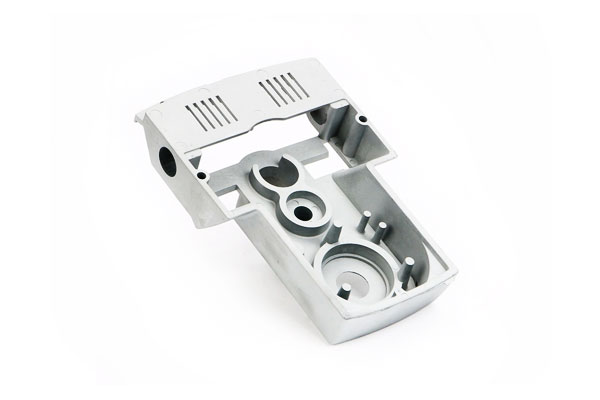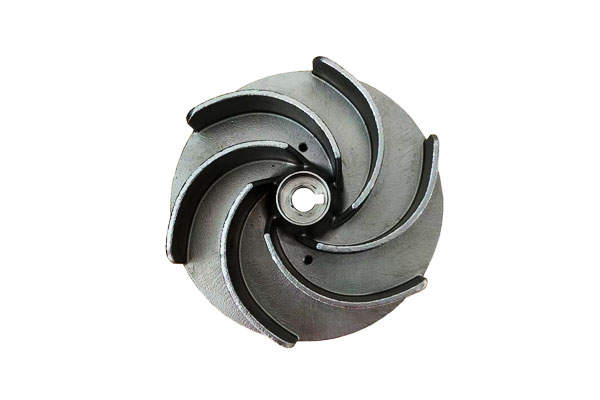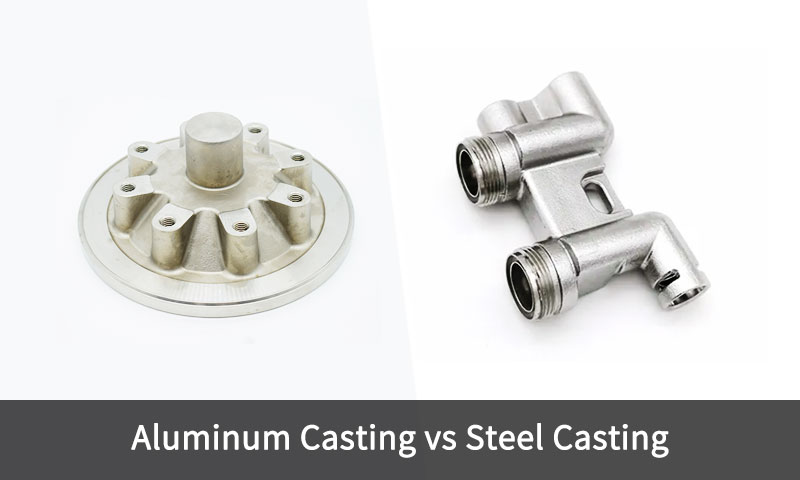1. مقدمة
Aluminum vs Steel Casting — choosing between these two foundational materials shapes component performance, cost and manufacturability across industries from automotive to energy.
This comparison is not merely about metal chemistry: it encompasses density and stiffness, السلوك الحراري, casting process compatibility, secondary processing (المعالجة الحرارية, هندسة السطح), lifecycle cost and application-specific reliability.
Engineers and purchasers must therefore evaluate the entire system—loading, درجة حرارة, بيئة, production volume and finish requirements—before specifying a metal and casting route.
2. Fundamental Material Differences Between Aluminum vs Steel
At the core of aluminum vs. steel casting lies a fundamental metallurgical and physical contrast that directly affects how each material behaves during casting, الآلات, والخدمة.
| ملكية | الألومنيوم (على سبيل المثال, al-i allays) | فُولاَذ (على سبيل المثال, carbon or low-alloy steels) | الآثار الهندسية |
| كثافة (ز/سم) | 2.70 | 7.85 | Aluminum is ~65% lighter, offering major weight savings for transportation and aerospace. |
| نقطة الانصهار (درجة مئوية) | 615-660 | 1425–1540 | Aluminum’s low melting point enables easier casting and lower energy consumption; steel requires specialized furnaces. |
| الموصلية الحرارية (ث/م · ك) | 120-180 | 40-60 | Aluminum dissipates heat efficiently—ideal for engines, المبادلات الحرارية, والإلكترونيات. |
| قوة محددة (MPa/ρ) | ~100–150 | ~70–90 | Despite lower absolute strength, aluminum’s strength-to-weight ratio surpasses that of steel. |
| معامل مرن (GPA) | 70 | 200 | Steel is stiffer, providing better rigidity under load and vibration. |
مقاومة التآكل |
ممتاز (forms Al₂O₃ layer) | عامل; prone to rust without coatings | Aluminum resists oxidation naturally, while steel needs surface protection (تلوين, تصفيح, or alloying with Cr/Ni). |
| القابلية للآلات | ممتاز | Moderate to difficult | Aluminum’s softness allows easy machining and shorter cycle times; steel requires tougher tooling. |
| Recyclabality | >90% recoverable | >90% recoverable | Both materials are highly recyclable, though aluminum’s remelting requires less energy (5% of primary production). |
| Casting Shrinkage (%) | 1.3-1.6 | 2.0–2.6 | Steel shrinks more during solidification, demanding larger allowances and more complex gating/feeding systems. |
| يكلف (تقريبا., USD/kg) | 2.0-3.0 | 0.8-1.5 | Aluminum is more expensive per kilogram, but savings in weight and processing can offset total lifecycle costs. |
3. What Is Aluminum Casting?
الألومنيوم صب is the process of shaping molten aluminum or aluminum alloys into complex, near-net-shape components using molds.
It is one of the most widely used metal casting processes globally—accounting for over 50% of all nonferrous castings—due to aluminum’s excellent castability, كثافة منخفضة, ومقاومة التآكل.

ملخص
In aluminum casting, الألومنيوم المنصهر (عادة بين 680–750°C) is poured or injected into a mold cavity where it solidifies into the desired geometry.
Aluminum’s low melting point and high fluidity make it ideal for both mass-production methods (like die casting) و تطبيقات عالية الدقة (like investment casting).
Key Features of Aluminum Casting
- نسبة خفيفة الوزن وعالية الوزن إلى الوزن:
Aluminum castings offer excellent mechanical performance while being about ثلث وزن الصلب. - مقاومة تآكل جيدة:
رقيقة, الشفاء الذاتي aluminum oxide layer (al₂o₃) protects against oxidation and most atmospheric or marine corrosion. - الموصلية الحرارية والكهربائية ممتازة:
Suitable for applications like المبادلات الحرارية, العلب, and electric components. - Recyclabality:
Aluminum can be recycled indefinitely without degradation, reducing production energy by up to 95% compared to primary smelting.
Common Aluminum Casting Processes
| طريقة الصب | وصف | التطبيقات النموذجية |
| يموت الصب | High-pressure injection of molten aluminum into steel dies; yields precise, أجزاء رقيقة الجدران. | قطع غيار السيارات (علب العتاد, قوسين), إلكترونيات المستهلك. |
| صب الرمال | Molten metal poured into sand molds; suitable for larger, lower-volume parts. | كتل المحرك, مشعبات, المساكن الفضائية. |
| صب الاستثمار | Ceramic molds from wax patterns; ideal for fine details and tight tolerances. | مكونات التوربينات الطيران, الأجهزة الطبية. |
| صب القالب الدائم | Reusable metal molds; good surface finish and dimensional control. | المكابس, عجلات, والمكونات البحرية. |
| الطرد المركزي الصب | Uses centrifugal force to distribute molten metal; كثيفة, بنية خالية من العيوب. | الأنابيب, الأكمام, and rings. |
مزايا صب الألمنيوم
- خفيف الوزن: Reduces component weight by 30-50 ٪ مقابل. فُولاَذ, تحسين كفاءة استهلاك الوقود (السيارات) or payload capacity (الفضاء الجوي).
- كفاءة الطاقة: Melting aluminum requires 60–70% less energy than steel (570° C مقابل. 1420درجة مئوية), lowering processing costs by 20-30 ٪.
- مقاومة التآكل: Eliminates the need for coatings (على سبيل المثال, طلاء, الجلفنة) في معظم البيئات, reducing maintenance costs by 40-50 ٪.
- High-Volume Viability: Die casting enables production of 1000+ parts/day per machine, meeting consumer goods demand.
Disadvantages of Aluminum Casting
- قوة أقل: قوة الشد (150-400 ميجا باسكال) is 50–70% lower than high-strength steel, limiting use in heavy-load applications.
- Poor High-Temperature Performance: Retains only 50% of room-temperature strength at 250°C, making it unsuitable for engine exhaust or power plant components.
- خطر المسامية: Die-cast aluminum is prone to gas porosity (from high-pressure injection), restricting heat treatment options (على سبيل المثال, T6 temper requires vacuum processing).
- Higher Raw Material Cost: Primary aluminum costs $2,500–$3,500/tonne, 2–3x more than carbon steel.
Industrial Applications of Aluminum Casting
Aluminum casting is widely used across multiple industries due to its combination of تصميم خفيف الوزن, القابلية للآلات, ومقاومة التآكل:
- السيارات: كتل المحرك, علب النقل, عجلات, and suspension arms.
- الفضاء: قوسين, التركيبات الهيكلية, علب الضاغط.
- الإلكترونيات: أحواض الحرارة, أدوات السيارات, حاويات.
- السلع الاستهلاكية: الأجهزة, أدوات الطاقة, أجهزة الأثاث.
- Marine and Renewable Energy: المراوح, العلب, وشفرات التوربينات.
4. What Is Steel Casting?
Steel casting is the process of pouring molten steel into a mold to produce complex, high-strength components that cannot be easily fabricated or forged.
Unlike aluminum, steel has a نقطة انصهار أعلى (≈ 1450–1530°C) and greater tensile strength, مما يجعلها مثالية ل load-bearing and high-temperature applications such as machinery, infrastructure, وتوليد الطاقة.

ملخص
In steel casting, carefully alloyed molten steel is poured into either expendable (رمل, استثمار) or permanent molds, where it solidifies into a shape close to the final part.
Because steel shrinks significantly upon cooling, precise temperature control, تصميم البوابات, and solidification modeling حاسمة.
Steel castings are known for their المتانة الميكانيكية, مقاومة التأثير, والنزاهة الهيكلية, particularly under harsh service conditions.
Key Features of Steel Casting
- Exceptional Strength and Toughness:
Yield strengths often exceed 350 MPA, with heat-treated alloys reaching over 1000 MPA. - High-Temperature Capability:
Retains strength and oxidation resistance up to 600–800°C, depending on composition. - Versatile Alloy Selection:
Includes فولاذ الكربون, الفولاذ منخفضة الفولاذ, فولاذ مقاوم للصدأ, and high-manganese steels, each tailored for specific environments. - قابلية اللحام والقابلية للآلات:
Cast steels can be post-processed effectively—machined, ملحومة, and heat-treated to enhance performance.
Common Steel Casting Processes
| طريقة الصب | وصف | التطبيقات النموذجية |
| صب الرمال | Molten steel poured into bonded sand molds; مثالي للكبير, أجزاء معقدة. | جثث الصمام, أغلفة ضخ, machinery housings. |
| صب الاستثمار | Ceramic molds formed from wax patterns; yields excellent accuracy and surface finish. | شفرات التوربينات, الأدوات الجراحية, أجزاء الفضاء. |
| الطرد المركزي الصب | Rotational force distributes molten steel evenly; produces dense cylindrical components. | الأنابيب, بطانات, تحمل السباقات. |
| قذيفة القالب صب | Uses thin resin-coated sand molds; allows higher precision and smoother surfaces. | أجزاء محرك صغيرة, قوسين. |
| صب مستمر | For semi-finished steel products like slabs and billets. | Raw material for rolling and forging. |
Advantages of Steel Casting
- قوة متفوقة & صلابة: قوة الشد (ما يصل الى 1500 MPA) وتأثير المتانة (40–100 J) make it irreplaceable for structural safety (على سبيل المثال, مكونات الجسر, هيكل السيارات).
- أداء درجات الحرارة العالية: Operates reliably at 400-600 درجة مئوية (مقابل. aluminum’s 250°C limit), suitable for jet engine casings and power plant boilers.
- Low Raw Material Cost: Carbon steel costs $800–$1200/tonne, 60–70% less than primary aluminum.
- ارتداء المقاومة: Heat-treated steel (على سبيل المثال, 4140) has surface hardness up to 500 HB, reducing replacement frequency in abrasive applications by 50-70 ٪.
Disadvantages of Steel Casting
- High Weight: Density 2.7x that of aluminum increases fuel consumption (السيارات) or structural load (المباني).
- High Energy Use: Melting steel requires 25–30 MWh/tonne (مقابل. 5–7 MWh/tonne for aluminum), increasing processing costs by 40-50 ٪.
- حساسية التآكل: Carbon steel rusts in moist environments (معدل التآكل: 0.5-1.0 مم/سنة in salt spray), requiring coatings (على سبيل المثال, الجلفنة) that add $1.5–$2.5/kg to costs.
- Poor Machinability: Hardness requires specialized tools, زيادة وقت التصنيع بواسطة 30-50 ٪ مقابل. الألومنيوم.
Industrial Applications of Steel Casting
Steel castings dominate industries demanding قوة, متانة, ومقاومة الحرارة:
- بناء & التعدين: Excavator teeth, أجزاء الكسارة, track links.
- طاقة & توليد الطاقة: Steam turbine casings, جثث الصمام, المكونات النووية.
- زيت & الغاز: Drill heads, pipeline valves, مشعبات.
- مواصلات: Train couplers, علب العتاد, heavy-duty engine blocks.
- الفضاء & الدفاع: معدات الهبوط, التركيبات الهيكلية, armor components.
5. مقارنة شاملة: الألومنيوم مقابل صب الصلب
Process fit and part geometry
- رقيقة الجدران, معقد, أجزاء عالية الحجم: aluminum die casting is optimal (HPDC).
- كبير, ثقيل, load-bearing parts: steel/spheroidal graphite (الدوقات) iron and cast steels via sand casting are preferred.
- Medium volume with high integrity requirements: low-pressure aluminum or investment casting steels depending on strength needs.
Mechanical performance & ما بعد المعالجة
- المعالجة الحرارية: cast steel can be quenched & tempered to obtain high strength and toughness; aluminum alloys have age-hardening routes but reach lower maximum strengths.
- Surface engineering: aluminum readily anodizes; steel can be nitrided, carburized, induction hardened or coated with hard substances (السيراميك, كروم الصلب).
سائقي تكلفة (typical considerations)
- Material cost per kg: aluminum raw metal tends to be priced higher per kg than ferrous scrap/steel, but part mass reduces required amount.
- الأدوات: die casting dies are expensive (high initial amortization) but low per-part cost at volumes >10k–100k; sand tooling is cheap but per-part labor higher.
- الآلات: aluminum machines faster (higher removal rates), lower tool wear; steel requires harder tooling and more machining time—raises total cost especially for small batches.
التصنيع & defect modes
- المسامية: HPDC aluminum can develop gas and shrinkage porosity; permanent-mold and low-pressure reduce porosity.
Steel castings can suffer inclusions and segregation; controlled melting and post-HT reduce defects. - التحكم في الأبعاد: die cast aluminum attains tight tolerances (± 0.1-0.3 مم); sand cast steel tolerances are looser (±0.5–2 mm) without post-machining.
البيئة & life-cycle
- إعادة التدوير: both metals are highly recyclable. Recycled aluminum uses a small fraction (~5–10%) of the energy of primary smelting; recycled steel also has large energy savings compared to virgin iron.
- Use-phase: lightweight aluminum can reduce fuel consumption in vehicles — a system-level environmental benefit.
طاولة: Aluminum vs Steel Casting — Key Technical Comparison
| فئة | صب الألومنيوم | صب الصلب |
| كثافة (ز/سم) | ~2.70 | ~7.80 |
| نقطة الانصهار (درجة مئوية / ° f) | 660درجة مئوية / 1220° f | 1450–1530°C / 2640–2790°F |
| قوة (الشد / أَثْمَر, MPA) | 130-350 / 70-250 (كما); ما يصل الى 500 بعد المعالجة الحرارية | 400-1200 / 250-1000 (اعتمادًا على المعالجة الدراسية والحرارة) |
| صلابة (HB) | 30-120 | 120-400 |
| معامل مرن (GPA) | 70 | 200 |
| الموصلية الحرارية (ث/م · ك) | 150-230 | 25-60 |
| الموصلية الكهربائية (% IACS) | 35-60 | 3-10 |
| مقاومة التآكل | ممتاز (طبقة أكسيد الطبيعية) | Variable — requires alloying (كر, في, شهر) أو الطلاء |
| مقاومة الأكسدة (High-Temp) | محدود (<250درجة مئوية) | جيد إلى ممتاز (up to 800°C for some alloys) |
| القابلية للآلات | ممتاز (ناعم, easy to cut) | معتدلة إلى الفقراء (أصعب, كاشط) |
| قابلية القابلية (سيولة & انكماش) | سيولة عالية, انكماش منخفض | Lower fluidity, higher shrinkage — needs precise gating |
| ميزة الوزن | ~65% lighter than steel | Heavy — suitable for structural loads |
الانتهاء من السطح |
سلس, good detail reproduction | Rougher surfaces; may need machining or shot blasting |
| Heat Treatment Flexibility | ممتاز (T6, T7 tempers) | واسع (الصلب, التبريد, تقع, التطبيع) |
| Recyclabality | >90% recycled efficiently | >90% recyclable but requires higher remelting energy |
| Production Cost | Lower energy, أوقات دورة أسرع | Higher melting cost and tool wear |
| التحمل النموذجي (مم) | ±0.25 to ±0.5 (يموت الصب); ±1.0 (صب الرمال) | ±0.5–1.5 depending on process |
| Environmental Footprint | قليل (especially recycled aluminum) | Higher CO₂ and energy footprint due to high melting point |
| التطبيقات النموذجية | عجلات السيارات, العلب, أجزاء الفضاء, السلع الاستهلاكية | الصمامات, التوربينات, آلات ثقيلة, المكونات الهيكلية |
6. خاتمة
Aluminum and steel castings solve different engineering problems.
Aluminum excels where وزن خفيف, الموصلية الحرارية, surface quality and high production rates matter.
فُولاَذ (and cast irons) dominate where قوة عالية, صلابة, ارتداء المقاومة, toughness and elevated temperature performance مطلوب.
Good material selection balances functional requirements, يكلف (total life cycle), producibility and finishing.
In many modern designs hybrid solutions appear (steel inserts in aluminum castings, clad or bimetallic components) to exploit the strengths of both metals.
الأسئلة الشائعة
وهو أقوى: cast aluminum or cast steel?
Cast steel is significantly stronger—A216 WCB steel has a tensile strength of 485 MPA, 67% higher than A356-T6 aluminum (290 MPA).
Steel also has far greater toughness and wear resistance.
Can cast aluminum replace cast steel?
Only in applications where weight reduction is prioritized over strength (على سبيل المثال, automotive non-structural parts).
Steel is irreplaceable for high-load, high-temperature components (على سبيل المثال, أغلفة التوربينات).
Which is more corrosion-resistant: cast aluminum or cast steel?
Cast aluminum is more corrosion-resistant in most environments (معدل التآكل <0.1 مم/سنة) مقابل. الصلب الكربوني (0.5-1.0 مم/سنة).
Stainless steel castings match aluminum’s corrosion resistance but cost 2–3x more.
Which casting process is best for aluminum vs. فُولاَذ?
Aluminum is ideal for die casting (الحجم العالي) and sand casting (منخفضة التكلفة).
Steel is best for sand casting (أجزاء كبيرة) والاستثمار الصب (معقد, high-tolerance components). Die casting is rarely used for steel.


